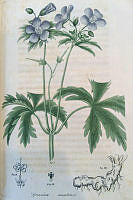Rubenstein Center Scholarship
Before the White House
This article is part of the Slavery in the President’s Neighborhood initiative. Explore the Timeline
On May 14, 1975, President Gerald R. Ford announced that construction of a new outdoor swimming pool on the White House South Lawn was underway, just south of the West Wing.1 During construction, National Park Service Curator Robert S. Marshall conducted archaeological analysis of the fill removed from the hole dug for the pool. In the fill, Marshall discovered: “seventeen chips, flakes, and other debris of quartz and quartzite, two quartz points, a broken biface or blank and fragment of pottery.” Archaeological work continued in 1976 when excavations on the White House Ellipse revealed “a broken biface, a small projectile point, and a flake of quartz.”2
For over 200 years, the White House has stood in the center of the nation’s capital, Washington, D.C. However, these archaeological findings indicate that the White House Grounds have a longer, deeper history than typically discussed or remembered, leading to the question—what existed before the White House? The stories of Indigenous peoples and enslaved individuals in the Potomac region are often cast aside when discussing the creation of Washington, D.C. and the White House—sometimes even eliminated entirely. However, there are over 10,000 years of human history in the region to consider before the White House’s construction began in 1792.
Tracing the Indigenous and enslaved people that lived in the Potomac Valley prior to the construction of the Federal City can be difficult. Since these groups did not often leave behind written records, historians must rely upon archaeological evidence, oral histories, and folklore. Unfortunately, the rapid and continuous development of Washington, D.C. over the past two centuries disrupted much of the region’s archaeology and little effort was made to record the extensive evidence that once existed. William Henry Holmes, an archaeologist in the late nineteenth and early twentieth century, once wrote about the abundance of artifacts in the District of Columbia: "in certain localities...they are brought in with every load of gravel from the creek beds, and the laborer who sits by the wayside breaking boulders for our streets passes them by the thousands beneath his hammer; and it is literally true that in this city, the capital of a civilized nation is paved with the art remains of a race who occupied its site in the shadowy past."3

President Gerald R. Ford and his daughter Susan Ford survey construction on the new swimming pool on the South Grounds on May 20, 1975. In the fill, National Park Service Curator Robert Marshall discovered American Indian archaeological evidence, including: "seventeen chips, flakes, and other debris of quartz and quartzite, two quartz points, a broken biface or blank and fragment of pottery."
Gerald R. Ford Presidential Library and Museum/NARAIt is likely that Paleoindians first moved into the Potomac Valley around 10,000 to 12,000 years ago, toward the end of the Pleistocene era, more commonly known as the Ice Age. Their environment probably resembled today’s northern Canada, with colder temperatures and dense spruce forests.4 Although no direct archaeological remains from this period have been uncovered within the boundaries of the District of Columbia, evidence from the surrounding region supports this conclusion. The Potomac Valley exists between two of the “most productive” discovered Paleoindian sites in eastern North America; the Williamson site in Dinwiddie County, Virginia, and the Shoop site in Lancaster County, Pennsylvania.5
These early Indigenous groups were likely nomadic and utilized stone tools. While archaeologists have been able to construct a picture of stone tool usage, they know little about housing and settlement patterns.6 Although one might think of early Paleoindians as big game hunters, like those found in the American West, big game was less readily available in the forests of the Potomac region, meaning that groups likely depended on smaller game, plants, reptiles, and shellfish as a food source.7
As the Ice Age concluded and large continental ice sheets retreated around 10,000 years ago, an environmental transformation occurred in the eastern United States. Pollen records indicate a shift from spruce forests to dense deciduous forests consisting of white pine, hemlock, birch, fir, ash, and oak. Warmer, drier conditions developed over time and the modern climatic conditions stabilized around 8,000 years ago.8 This transition allowed Indigenous peoples in the Potomac region to expand and develop throughout the Archaic period (10,000 to 3,000 years ago) resulting in technological developments in basketry, wood tools, stone tools, and the introduction of a hunting weapon called the atlatl. During the Archaic period, stone mortars, pestles, and milling stones begin to appear in the archaeological record, indicating a greater dependence on food gathering and processing. Groups subsisted on nuts, seeds, wild grain, fish, mollusks, shellfish, and game. The excavation of midden deposits, or trash dumps, signals that groups were semi-nomadic, moving through river valleys, like the Potomac Valley, in pursuit of seasonal food resources.9
During the Woodland period (1000 BCE-1200 CE), Indigenous groups continued to expand geographically as populations increased. Sometime between 800 and 1000 CE, groups in the Potomac region were introduced to maize agriculture, further altering societal structure and establishing more sedentary societies.10 Archaeological evidence indicates that a flourishing trade network, connected by the region’s interconnected waterways, linked groups up and down the East Coast. Advancements were also made in pottery and tool production, including the introduction of bows and arrows as hunting tools.11
The archaeological remains are particularly rich from the final two centuries before the invasion of Europeans. Excavation of granaries, warehouses, and refuse middens in Potomac region village sites demonstrate that Indigenous groups like the Piscataway settled in “horticultural base camps” which were occupied year-round. These groups practiced slash and burn style agriculture and primarily subsisted on shellfish, deer, squash, beans, maize, wild rice, and amaranth, a type of grain used to make flour. In addition, the discovery of funeral sites, decorative items made from bone, and advanced tools suggest that these were well-developed societies.12

This map, attributed to Captain John Smith, was one of the first maps to depict the Chesapeake Bay. The map also depicts the locations and names of the Indigenous peoples living in the area. Originally published in 1612, the map is one of the most significant maps depicting colonial Virginia.
Library of CongressOn the eve of European colonization, there were several village sites within and around the invented boundaries of the District of Columbia. One village, Nameroughquena, stood on the west bank of the Potomac River across from today’s Theodore Roosevelt Island, while a second unnamed village was located between today’s C&O Canal and MacArthur Boulevard in Northwest Washington, D.C. The principal village in Washington was called Nacotchtank, located on the east bank of the Anacostia River in between today’s Bolling Air Force Base and Anacostia Park. The Nacotchtanks were well positioned near the confluence of the Anacostia and Potomac Rivers and established Nacotchtank as a flourishing hub for trade.13 They were closely associated with the Piscataway people, paying tribute to the Piscataway chief who had an established village called Mayone in what is now Prince George’s County, Maryland.14
In 1607, life for the Indigenous peoples of the Potomac region changed forever when English colonists from the Virginia Company settled along the banks of the James River, naming their new home Jamestown. Although the colony initially seemed doomed to fail after struggles with starvation, disease, and violent episodes with the local Powhatan empire, within just one hundred years, European settlers in Maryland and Virginia had eclipsed the once thriving Native American world.15
For the Nacotchtanks, one of their first contacts with these European interlopers was with Captain John Smith. As one of the original settlers of Jamestown, Smith participated in several exploratory expeditions around the Chesapeake Bay. In 1608, Smith ventured out beyond Jamestown with a company of fourteen companions and became the first person of European descent to explore the area that would become the District of Columbia.16 In mid-July, Smith visited Nacotchtank as well as the nearby Piscataway village Mayone, writing of the experience, “at Moyaones, Nacotchtant and Toags the people did their best to content [sic] vs.”17 Since the villages Smith visited were part of the Piscataway Confederacy, they had additional incentive to greet Smith warmly, hoping to ally themselves with the English against the powerful Powhatan in Virginia.18
This initial experience with the English had limited effect on the Nacotchtanks and they experienced minimal disruption to their way of life during the first ten years after contact. Although they avoided the First Powhatan War (1609-1614) between English colonists and the Powhatan, they were unable to avoid the Second Powhatan War in 1622. To gain allies in their fight against the Powhatan, the English approached the Patawomekes, an independent group that lived near today’s Quantico, Virginia. The Patawomekes agreed to side with the English if they would join in a raid against the Piscataways. As a result of this agreement, an English raiding party descended upon Nacotchtank, killing eighteen men, burning homes, and plundering food supplies. In 1623, the Nacotchtanks retaliated by killing twenty English traders visiting Nacotchtank and seizing a trader named Henry Fleet as their hostage.19 Fleet was held in captivity for five years until he was ransomed.
Despite this experience, Fleet and his brothers went on to establish a flourishing trade business, eventually monopolizing beaver trade on the Upper Potomac. He even continued to trade with the Nacotchtanks, writing of a 1632 trading expedition, “at the little town by him called the Nacotchtanks, where I had almost 800 weight of beaver...The Nacotchtanks before, here occasioned the killing of twenty men of our English, myself then being taken prisoner and detained five years.”20 Unfortunately, Fleet’s successful establishment of trade in the Upper Potomac undermined the Nacotchtanks’ trade market. After this visit, he continued up the Potomac determined to meet with the Massawomecks, another rival group. Through negotiations, Fleet was able to cut his former captors out of the beaver trade on the Upper Potomac.21

This 1670 map of the middle reaches of the Potomac River gives the location of the future site of the new Federal City to the east, labeled "Turkey Buzzard Point." Notably, the map makes no mention of the Nacotchtanks. By this point in time, all of the land in the area had been claimed by colonists and the Nacotchtanks had been forced out of Nacotchtank. Many took up residence at the Piscataway settlement, Mayone, depicted on this map as "Piscattawaye." The map was created by Augustine Herrman.
Library of CongressIn the 1650s the Nacotchtanks faced an additional threat—tobacco. After a rocky start, the colonies of Maryland and Virginia rapidly expanded after tobacco became a lucrative cash crop. Maryland in particular began a period of rapid expansion in the 1650s and 60s as farmers moved outward from the colony’s capital, St. Mary’s City. They headed north, clearing land up the Potomac to plant large tracts of the crop.22 In 1663, Maryland’s proprietor, Cecilius Calvert, granted land patents along the confluence of the Anacostia and Potomac Rivers, including a large 850-acre tract of land near today’s Bolling Air Force Base called Gisborough. Thomas Dent received this patent and created one of the most prominent estates in the District of Columbia area.23
With colonists living so close to the Nacotchtanks, it is unsurprising that the Maryland Assembly made deliberate efforts to challenge Native American control and access to the region just three years later. The 1666 Articles of Peace and Amity, a “treaty” with the Piscataway, helped establish a reserve at the Piscataway capital of Mayone. Although the treaty stated that, “Indians shall not be forced or removed,” the establishment of the reserve, coupled with the increased land development nearby, forced the Nacotchtanks to abandon Nacotchtank.24 By 1670, all the land in future Washington, D.C. had been claimed by colonists, effectively ending the influence of Nacotchtanks in the area. Some Nacotchtanks settled near Mayone, while others relocated to the village near Theodore Roosevelt Island. Eventually, some Nacotchtanks likely moved further west, attempting to distance themselves from Europeans in the wake of war, disease, disruption to their trading networks, and European settlement on their former lands.25
The 1666 Articles of Peace and Amity also addressed the legal relationship between Native Americans and enslaved African Americans by including this clause: “In case any servants or Slaves run away from their Masters & come to any of the Indian Townes...Indians shall apprehend them & bring them to the next English plantacon to be Conveyed to their master.”26 This provision demonstrated that the institution of slavery had already begun to flourish in the expanding colonies as Indigenous groups were forcibly pushed further and further from the Potomac region. Wealthy planters established a plantation society on the lands that would become the future capital. Enslaved workers toiled in the fields day after day, harvesting tobacco that made their owners immensely wealthy.
The first towns to emerge in the Washington area were a direct result of the tobacco plantation system. In 1730, a warehouse was established on the western bank of the Potomac River to ready tobacco for shipment. By 1749, the expanded settlement was incorporated as the town of Alexandria. In 1751, the site of a tobacco inspection station became Georgetown, Maryland.27
When it came time to select a site for the new United States capital, President George Washington advocated for a site along the Potomac River, close to his Mount Vernon estate and the bustling towns of Georgetown and Alexandria. The location was attractive to Washington for the same reason the area had been attractive to the Nacotchtanks—trade. He believed that the deep and navigable Potomac River held great potential for the development of trade and commercial ventures.28 Washington and other supporters of the Potomac location, including Thomas Jefferson, also believed that its position between the slave states of Maryland and Virginia ensured that plantation society would thrive and the government would protect the institution of slavery. Click here to learn more about the enslaved households of President George Washington.

This map depicts the landholdings within the proposed boundaries for the District of Columbia prior to the construction of the Federal City. Although it was created in 1874, it compiles historic information about landownership to create the map. It depicts the land holdings of David Burnes, the man who owned the land where the White House exists today.
Library of CongressOn July 16, 1790, Congress passed the Residence Act officially moving the nation’s capital from New York to Philadelphia for ten years, and then permanently to the Potomac. Immediately, President Washington went about planning the new Federal City. He employed Andrew Ellicott to survey the land and Pierre (Peter) Charles L’Enfant to design the new city. Meanwhile, Washington negotiated directly with local landowners to purchase the required land. When the landed gentry received word about the new city, many willingly agreed to sell their land. In late March 1791, President George Washington met with landowners at Suter’s Tavern in Georgetown and participated in successful negotiations.29 In a letter to Secretary of State Thomas Jefferson on March 31, 1791, Washington relayed his success, noting, “even the obstinate Mr. [sic] Burns has come into the measure.”30 Click here to learn more about the enslaved households of President Thomas Jefferson.
The “Mr. Burns” in question was a particularly stubborn Scottish planter by the name of David Burnes, who happened to own the land Washington envisioned as the future site for the President’s House. Although other planters were excited about the prospect of a capital city, Burnes was primarily concerned with getting as much money out of the negotiations as possible. At first, he stubbornly refused to sell, and then, even after agreeing to sell, gave more demands to the president and the appointed Commissioners of the District of Columbia responsible for constructing the new city.31
According to the 1790 census, taken one year prior to agreeing to sell his land, Burnes owned twelve enslaved individuals and depended on their labor to work his nearly 350 acres.32 These enslaved people likely also worked within Burnes’ small farm cottage located west of the Ellipse on the site of today’s Pan American Union Building. Burnes was certainly not the wealthiest of the planters selling their land to the federal government and he owned significantly less enslaved people than his fellow neighbor and landowner, Notley Young, who owned 265 enslaved people according to the 1790 census.33
Even after Burnes agreed to sell to the government, he continued to quarrel with Washington and the commissioners about his land. Burnes had already sold the square of land for the President’s House and was waiting to sell additional lots until lot sales were made available for purchase. Until the lots went on sale, Burnes was financially unstable and sold eight of his twelve enslaved people to cover some of the debts he owed to creditors.34 Burnes also worried that the new city streets cutting through his property were diminishing potential land value, writing to President Washington on February 12, 1793: “You informed my Son the Commissioners would do every thing that was right if they had done right in my opinion they would have paid me for the Presidents Square Octr 1st 1791 when they began Occupying the above mentioned Square and I deprived of the use of the Ground…I possess no other Lands than those in the Center of the City All cut up and rendered useless for farming.”35 Burnes was eventually compensated for eighty acres of his land determined to be good for public sale.36

This map depicts the land, mansion house, grave yard, and buildings belonging to Mr. Notley Young, one of the landowners that contributed land for the construction of Washington, D.C. Young owned 265 enslaved individuals in 1790, just prior to selling his land.
Library of CongressWhile extensive documentation of this contentious land sale exists, little else is known about the enslaved individuals that planted and worked the land upon which the White House was built.37 This gap in the historical record is unfortunate but unsurprising. Just like the Native Americans before them, there are few written records available to reconstruct the day-to-day lives of the enslaved workers. The White House is often called “the people’s house,” so it is important to acknowledge all the people that used the land throughout thousands of years of human history. From early Indigenous peoples, to the Nacotchtanks, to the enslaved individuals forced to harvest tobacco from its fields, the land upon which the White House is built has many stories to tell. Perhaps additional archaeological research could bring to light more information about the Indigenous and enslaved people that once called it home.







